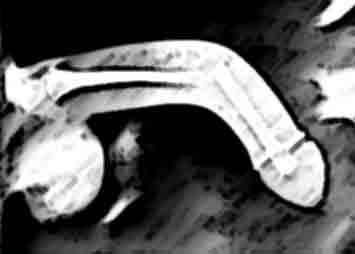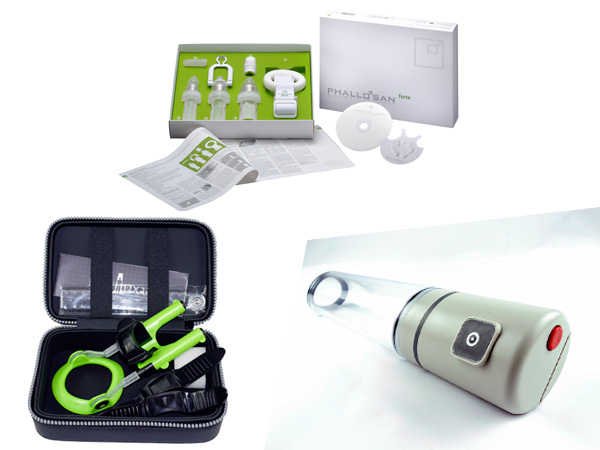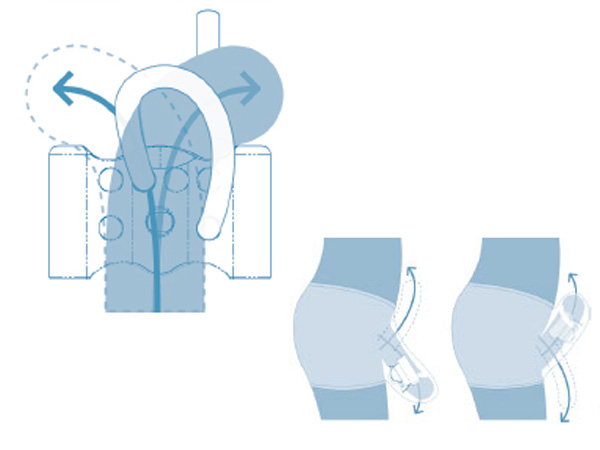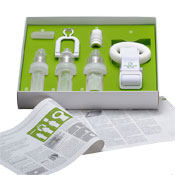Penile Fracture And...
Lots Of Questions About Peyronie's Traction Therapy (Vacuum pump vs. traction, Phallosan Forte, budget options)
Peyronie's Question
Hi, I appreciate that you've created this website. First a little background. (My questions don't begin until paragraph 5). I'm not the typical Peyronie's patient in that the problem started after I had surgery for "penile fracture syndrome."

I didn't realize that penile fracture was even possible, and my fracture wasn't typical either. I was having rather usual sex in missionary position. Normally when PFS occurs, the woman is on top and the fracture occurs after accidental withdrawal followed by a "miss," i.e., impact. In my case, it was just intravaginal bending. I heard/felt the pop and immediately knew something was wrong, but I wasn't in pain or particularly worried until I saw grotesque, bulbous swelling on the right ventral side of the base of my shaft.
It happened at about 5am on June 30, and I hadn't fallen asleep. I was disturbed enough to consider researching the issue right away, but I was exhausted and fell asleep. When I awoke in the afternoon, my entire shaft and scrotum was bruised dark purple, but still I was not in serious pain. I stupidly delayed going to the emergency room until the next day, July 1, and the surgeon wasn't available until July 2, so I was admitted to the hospital for the night. The longer you wait before surgery, the greater the risk of complications. The sooner the better, but most sources seem to strongly recommend having surgery within 48 to 72 hours. It ended up being about 53 hours. My surgeon assured me that was fine, but apparently he was wrong.
A better word for "fracture" might be "rupture," and the rupture occurred where I saw the bulbous swelling--on the right ventral side of my shaft at the base. That's where the plaque/scar tissue is, so unlike most Peyronie's patients, the curve is mostly downward and toward the right. Previously it had curved slightly upward and to the left but not in an abnormal way. So although the curvature may not seem look severe (no idea how to gauge the percentage), it's very different from before. Curving up is much better than curving down, in my opinion. The way it is now, it is much more difficult to insert it for intercourse. I have to use my hand much more than before. There is also a minor hourglass effect. The girth changes a little, with a slight narrowing just above the base (where the plaque is). Plus, it seems like I lost an inch in length, maybe more. I can get an erection and have intercourse, but neither the erection nor intercourse is anywhere near as good as before. I'm extremely depressed about it.
I did not like my surgeon's attitude to my complaint, so I asked for a referral. I waited a month to see the guy he referred me to, only to be told he wasn't a Peyronie's specialist! He referred me to someone else, whom I had to wait another month to see but he is apparently the nearest leading Peyronie's expert. I finally saw him on Wednesday. He recommended a series of 12 biweekly verapamil injections. The problem is that my current health insurance runs out on Dec. 31 and is not available next year (see below). In any case, we decided to fit in as many Verapamil injections as possible. We'll be doing it approximately every 10 days instead of 14 days, but still I will only have time for 5 instead of 12.

[I don't know if you've been following the health insurance disaster in the United States, but all the good insurance plans are being removed from the AHA (Obamacare) exchange. If you don't get insurance through your employer, your options are now very bad and very expensive. My Peyronie's specialist is certainly not in any of these other plans, and there may not even be a urologist who deals with Peyronie's. I cannot count on getting any verapamil injections or any other quality help after Dec. 31.
I have done lots of research, and there were two things my doctor said that seemed to contradict the research. One, he said he only prescribed Pentox for pain, not to reduce curvature. I have found plenty of articles suggesting a pretty clear role for pentox in reducing curvature. He ended up prescribing it to me anyway because he said it wouldn't hurt me. So I will try it, but I'm curious what you've learned about pentox in terms of reducing curvature, either from your own experience or through research. (I know you try to avoid medication. I'll do almost anything if it helps.)
The other thing my doctor said that surprised me (partly because it contradicts what you say on your website) is that a vacuum pump can help reduce curvature. He ackowledged that traction works too. (He actually recommended Andropenis over Andropeyronie.) But he said the amount of time required for traction to work makes vacuum pumps much more realistic and convenient. I don't like the idea of wearing traction for 4 hours a day myself, but I don't want to pay for a vacuum pump if it doesn't help curvature. I see lots of studies about the effectiveness of traction. Some of them say that vacuum pumps may also help, but every reference to their effectiveness that I have found points to this single study ![]() . Whenever a claim is backed by only one study, I am skeptical. And I know that you're skeptical. Could you point me to any research that backs up your point of view?
. Whenever a claim is backed by only one study, I am skeptical. And I know that you're skeptical. Could you point me to any research that backs up your point of view?
With respect to the Androvacuum, I certainly don't want to pay $230 for something that won't help. I realize that both traction and vacuum pumps are very cheap compared to most treatments (at least when not covered by insurance), but I still have to be careful. I also know you believe controlling the pressure and having a medical grade device is very important, but I have seen quite a few vacuum pumps that get decent reviews that cost about $100. (My doctor said I could pick one up in a sex shop for $40, and this guy is supposed to be the best in town!) Even if can't endorse them and wouldn't use them yourself, are there any less-expensive (like half the price of the Androvacuum) that you've read good things about? Again, I won't take what you say as a recommendation...
I'm definitely also considering getting a traction device (instead of, or in addition to, a vacuum pump). I'm a little confused by the Andro-brand options. The least expensive option seems to be called Androextender, not Andropenis, and the only models with Andropenis in the name are Andropenis Gold and Andropenis Gold Premium. Which one did you use? My bet is that the Androextender used to be called the Andropenis....
The main difference between the Androextender and the Andropenis Gold is that the former is made with aluminum and the latter is made of an alloy, including gold, to prevent allergies. (I'm not worried about allergies.) The other difference is that the Androextender comes with fewer "spare parts," but you can buy a "Comfort Kit" ($50) if you need more spare parts for a long treatment. So unless you convince me otherwise, I think I'll go with the Androextender.

Finally, when I first read about the Phallsan Forte, I got the idea that it would combine the benefits of traction and vacuum in one device. However, on closer reading, it seems to be just a traction device that uses vacuum technology to hold the end of the penis, which is not the same thing. What I don't understand is why only the Phallosan Forte can be used while sleeping. Andropenis devices are not supposed to be used for more than 2 hours at a time, but that's because *traction* is not supposed to be used for more than 2 hours at a time, right? If the Phallosan uses traction, why would it be any safer to use for longer periods of time, like while sleeping? I don't see why the method of attachment (noose, strap, vacuum) would matter, except in terms of comfort. The idea of being able to use traction while I'm sleeping is very appealing to me, so for me this question is very important. If your recommendations come simply from the manufacturer's recommendations, then I'm skeptical. It seems to me either that using the Phallosan for 8 hours straight is risky or that using the Andropenis for more than 2 hours straight is not very risky.
May I ask you how many hours a day you used Andropenis? I'm trying to get a sense of how much effort, inconvenience, and discomfort it requires to get a benefit. My doctor recommended a minimum of 2 hours a day, but I have read that at least 4 is necessary. I guess it was worth it for you, and I can't think of anything I'm more concerned about, so I guess I should just get started?
Thank you very much for reading my rambling letter. And thank you in advance for any responses you might have.
T
My Peyronie's Answer
Dear T
Thank you for your (long) e-mail and thank you for your kind words about My Peyronie's. I want to start by emphasizing that I'm not a medical doctor (as stated on my website). I can therefore not advice you on medical issues, you will have to see your doctor for that. I can only advice you generally, as a "friend" and fellow sufferer. I'm linking to articles on my website for further information as I feel appropriate.
I'm very sorry to hear about your ordeal and condition. I believe your story is important read so thank you for sharing your experience.
This article actucally contains answers to many of your questions but not others so I will try to address them all as best I can….
Pentoxifylline (Pentox)
I have not usedPentoxifylline myself but researched the topic. There have been some indications that Pentox may improve scarring and reduce the calcification of plaques in men with the Peyronie's disease, as well as improve erection quality through improved blood circulation.
Many Peyronie's specialist therefore use Pentox as part of their treatment plan, e.g. Dr. Levine, Dr. Paulis, Dr. Khera, Dr. Ralph, Dr. Hellstrom, etc. Pentox is generally well tolerated so personally I find it worth considering as part of combined treatment plan.
This article contains more information about Pentox, including link to some scientific studies.
Vacuum Pumps Vs. Traction Device
This article actually covers this topic, i.e. when is vacuum pump or traction device more suitable.
Some doctors do indeed recommend vacuum pump over traction device. Many do so as they don't trust their patient will wear the traction devices for as long as needed to see proper results. However, most agree that traction devices are better suited for penis enlargement and penile curvature.
The purpose of vacuum pumps is to help men to achieve and maintain firm erection by creating tension in the penis. When used to treat curvature men use the pump twice a day for around 10 minutes each time, or 20 minutes in total.
However, when treating penile curvature more is more, i.e. the more traction you apply and for longer the better results you can expect. For best results it is recommended to use traction devices for... braise yourself... for up to 8 hours per day.
Because you get better results by using traction device for more hours per day for shorter period (say 8 hours per day for 6 months) than for fewer hours and longer period (say 4 hours for 12 months)
This is why I (and many doctors, e.g. previously mentioned Dr. Levine, Dr. Hellstrom, Dr. Khera) believe traction devices to be more suitable for treating curvature than vacuum pumps. There are also more scientific backing for the use of traction devices to treat Peyronie's (only seen the study you refer to regarding vacuum pumps).
| Penis Pump Or Traction Device? | Pump | Traction |
|---|---|---|
| Erection Quality | Yes | |
| Penis Curvature | Yes | |
| Convenience | Yes | |
| Less Risk | Yes |
What Kind Of Vacuum Pump To Use
So personally, I would go for traction device if I was you but if you decide to go for vacuum pump (or both) then I personally would not risk anything that could aggravate my condition. You are still in the acute phase meaning your condition may still be progressing and the last thing you want is to do anything to aggravate your condition now (which is also why you need to take some care when having sexual intercourse).
This is why I don't like the idea of manual penis pumps or penis exercises (unless conducted under professional guidance). I cannot recommend any specific brands, the only pump I have tested is Androvacuum which fulfill my criteria for vacuum pumps.
Another thing worth having in mind when deciding on using penis pump or not is the severity of the curvature (if the curvature is severe than the cylinder can be restrictive). This is why FDA recommends that the labeling for vacuum pumps includes the following precaution:
“use of a vacuum pump may aggravate already existing conditions such as Peyronie's disease (the formation of hardened tissue in the penis that causes pain, curvature, and distortion, usually during erection)” (FDA External Penile Rigidity Devices Guidance
)
Traditional Vs. Directional Traction Devices
This article actually explains the difference between these two types of devices, e.g. the difference between Andropenis and Andropeyronie.
There is little evidence available that directional devices work better than the traditional one but common sense says it may help to be able to control the direction of the traction (or at least not harm). So all things being equal / similar (like price) then men may as well go for directional devices.

However, men can and have reached good result with using traditional devices (I for one used Andropenis). Most studies that have been done have also used traditional devices.
You can get cheaper devices but just bear in mind you usually get what you pay for. It can be bit challenging to compare what is the difference between the devices but the more expensive units tend to be more "sturdy" to wear and contain more comfort kit (and comfort is important as it increases the likelihood of men wearing the device for the extended period required).
I have not seen or tested Androextender but of those I have tried, I found Male Edge the most comfortable of the traditional devices (or as those things are comfortable to wear… most though get used to it soon enough). Male Edge would be my personal choice if I were not going for directional device.
Phallosan
Phallosan is another interesting option in my opinion. Both it is the most comfortable to wear and as you point out you can sleep with it. You question why which is a very good question that I will do my best to answer in layman terms.
First of all, yes that is what the manufacturers say (and in this case I would take their words for it!). I think it would actually be pretty obvious as soon as you try the device on why it is not wise to sleep with traditional traction device. The penis is restricted. When you sleep, you do not control your movements and the metal rods could make it very uncomfortable. The penis glans is also restricted, meaning the blood flow is also restricted.
Taking break every 2 hours is not only manufacturer's recommendation, it is the penis recommendation as well. I found that if I forgot the time my penis would remind me to take a break. So I would take the manufacturers word for it and would not try to sleep with traditional devices.
Phallosan traction works differently. Your penis is in a "condom" (sleeve) which means it is less restrictive. The device is attached to the body with an orthopedic belt that is elastic. Because of that it will move with your body, avoiding any additional tension or pull against your skin (while other traction devices are rigid). It is a bit difficult to explain this but I did try to sleep with Phallosan and found it no problem. So again, happy with the manufacturers recommendation.
The biggest downside with Phallosan is however the price, it is more expensive and the sleeves are bit delicate and if men are not careful may need extra sleeves and they are expensive. So if you can wear traditional device during the day then you may want to stick to it.
Commitment
You say you are trying to "get a sense of how much effort, inconvenience, and discomfort it requires to get a benefit". I have already addressed most of this but let's summarize!
Traction therapy requires commitment…. and lot of it! The more hours you put in the better results you can expect. For correcting penile curvature, I would recommend putting in 8 hours every day and expect to do so for 3 – 6 months.
For penis enlargement purposes, men can realistically expect between 0.5 – 1 cm in penile length per month of use. So to increase the penile length by 1 - 2 inches (2.5 – 5 cm) men are likely to have to use the traction device for 6 - 10 hours daily for 3 - 6 months.
Regarding the inconvenience and discomfort. Most men get used to wearing the device soon enough. You should though expect it to take few days to get proper hang of putting the device on and to get used to wearing the device. It is not comfortable to wear the devices as such but not too uncomfortable either. In my opinion well worth the potential gain. The device may though restrict some movements so it may not be suitable to wear during working hours for some men, e.g. those doing manual labor or while driving.
Same applies about the inconvenience. Yes, you need to take the device off to pee but you anyway need to take the device off every two hours. Well worth the effort in my opinion.
What results can you expect? There are no guarantees but there is no question that traction does lengthen the penis if worn for extended period of time (think of long neck Kayan women in Burma). Many men have seen great results in reducing their penile curvature. You have seen studies, read my story and this is another success story. So personally, I find traction worth trying for all men, especially for those with mild or moderate curvature and in their acute phase (as you are). The worst thing is to regret something afterwards. If only I… This is the right time to prioritize your penis health. It is among the most important thing in your life right now.
I hope I have managed to answer your questions satisfyingly and I wish you all the best with your treatment and hope you will keep us posted about your progress.
Kind regards,
Birgir





